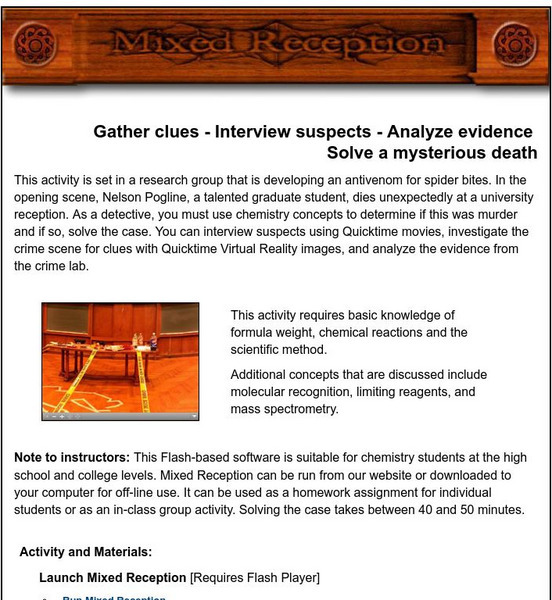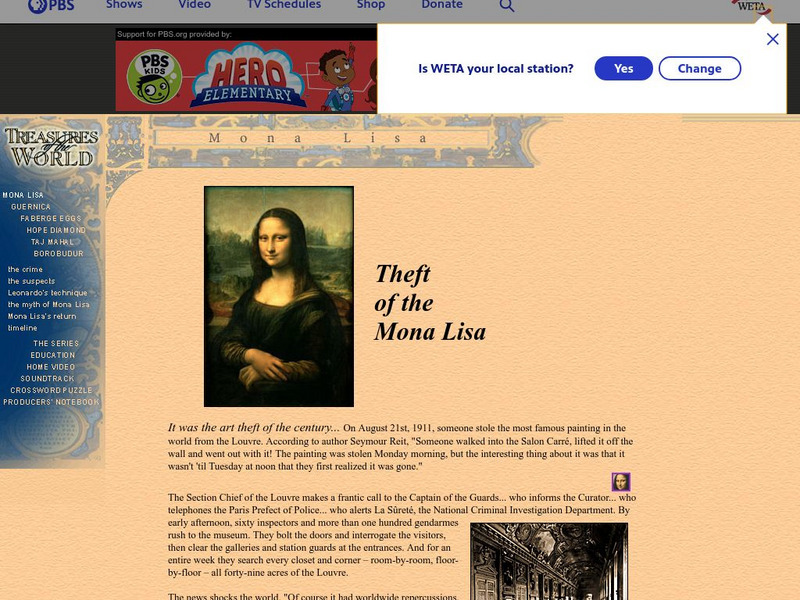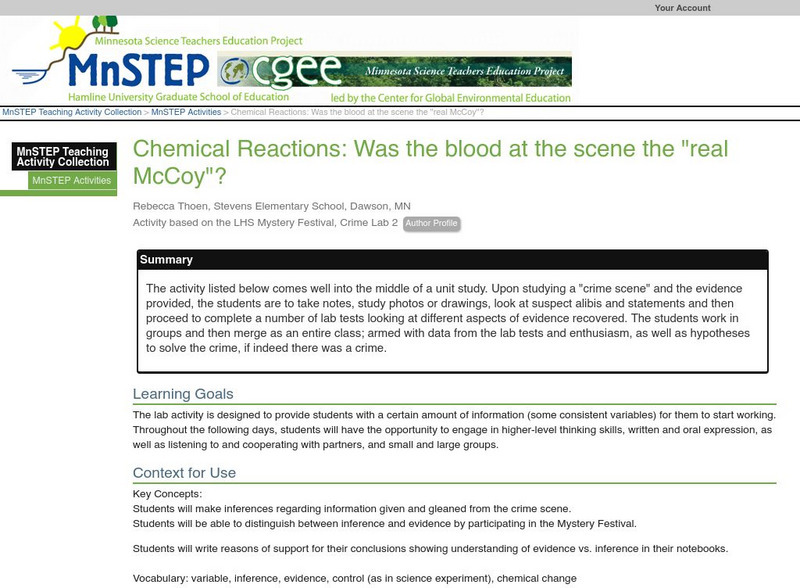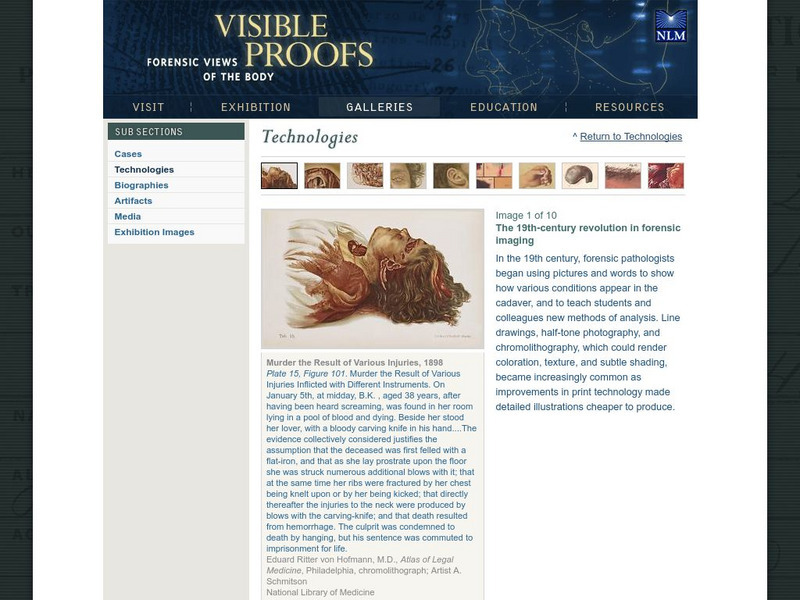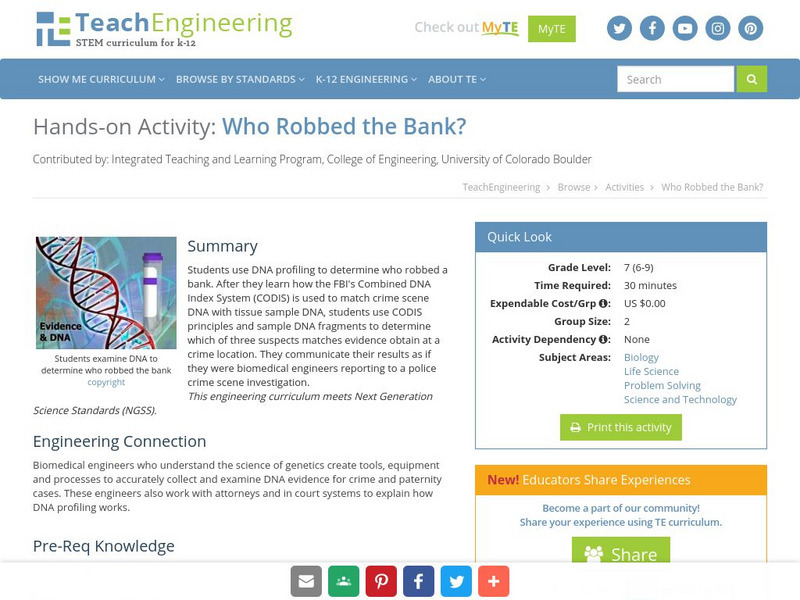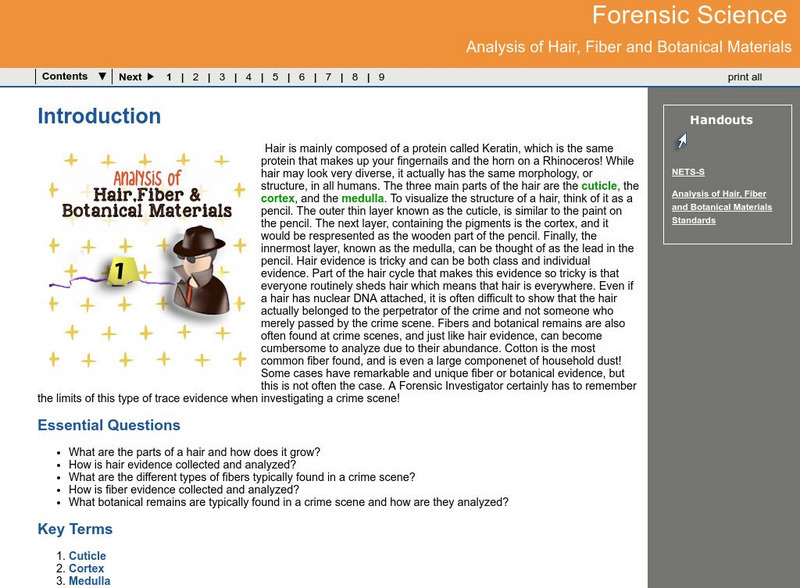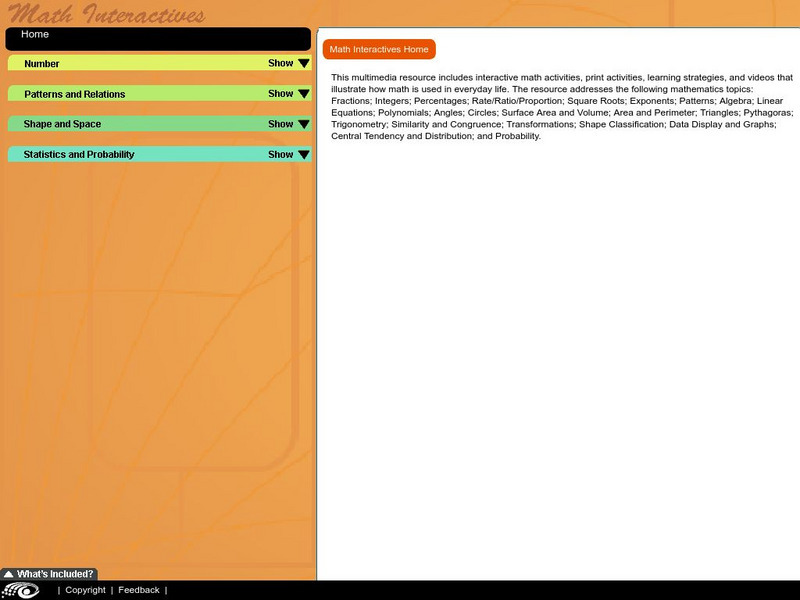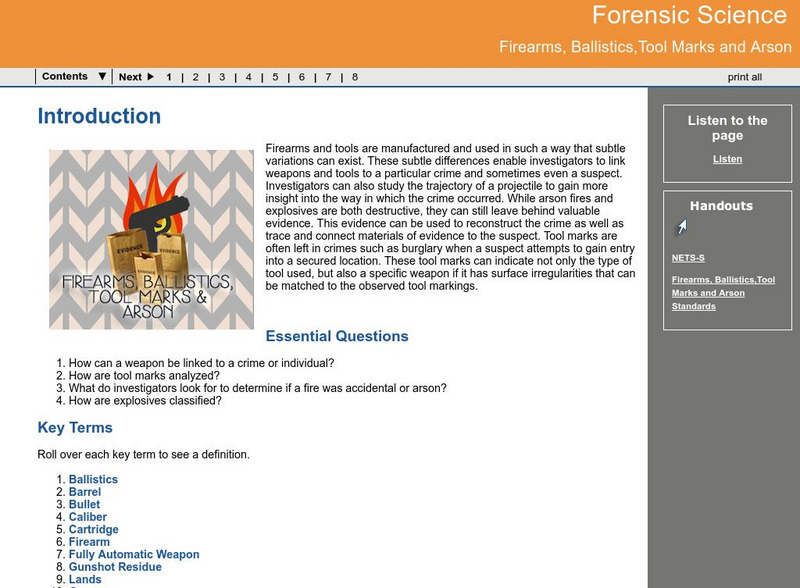Hi, what do you want to do?
Chemistry Collective
Chem Collective: Mixed Reception
Participate in the investigation of a virtual crime scene using chemistry concepts to solve a mysterious death. The 40-50 minute activity can be used as a classroom lab or as a homework assignment. Additionally, teachers may request a...
Federal Bureau of Investigation
Fbi Youth: Grades 6th 12th
Explore the FBI by joining agents as they investigate crimes around the world, following a case through the FBI Lab, look at a day in the life of an FBI agent, and more!
Science Education Resource Center at Carleton College
Serc: Chromatography: Who Wrote the Note?
Students investigate who stole the class pet by testing the chromatograph of different markers as a way to find the evidence that points to the perpetrator.
Federal Bureau of Investigation
Fbi: Famous Cases and Criminals: Bonnie and Clyde
A detailed account of the background, crimes and capture of famous criminals Clyde Champion Barrow and Bonnie Parker. Links to the FBI's archives featuring remarkable primary documents relating to the couple's misdeeds.
Other
Crime Scene Investigation: Proper Tagging and Labeling of Evidence
What is the purpose of tagging and labeling items of evidence? What information belongs on the tag? These questions are answered in this concise but competent site.
PBS
Pbs Treasures of the World: Theft of the "Mona Lisa"
A PBS site describes the 1911 theft of the "Mona Lisa." Retells the story of the crime, investigates the suspects, and traces its return to the Louvre.
Science Education Resource Center at Carleton College
Serc: Chemical Reactions: Was the Blood at the Scene the "Real Mc Coy"?
The activity listed below comes well into the middle of a unit study. Upon studying a "crime scene" and the evidence provided, the young scholars are to take notes, study photos or drawings, look at suspect alibis and statements and then...
Natural History Museum
Natural History Museum: On Maggots and Murders: Forensic Entomology [Pdf]
Five-page article explains how forensic scientists, when investigating crimes, analyze maggots and blowflies to determine approximate times of death.
National Health Museum
Access Excellence: Dna Detectives
A hands-on activity from Access Excellence for advanced biology classes. Students are given a crime scenario and three suspects. Their mission is to determine 'Who Dunnit?' by obtaining and analyzing DNA samples. Requires extensive...
Science Struck
Science Struck: Locard's Exchange Principle in Forensic Science
'This resource describes some of the history of forensic science and what Locard's Exchange Principle is and how it is applied. Discusses the different types of trace evidence that investigators look for and some drawbacks of Locard's...
University of Missouri
Famous Trials: West Memphis Three Trials (1994)
On a warm sunny May day three eight-year-old boys set off on a bike ride around their hometown of West Memphis, Arkansas. The next afternoon, their bruised and mutilated hog-tied naked bodies were pulled from a stream, setting off an...
University of Arizona
University of Arizona: Adn en Medicina Legal 1
Learn about the polymorphism method to characterize human DNA samples as applied in the analysis of paternity and sex crimes investigations. You will have the opportunity to interpret results as those obtained in the FBI laboratory or a...
University of Arizona
University of Arizona: Adn en Medicina Legal 2
Learn about the polymorphism method to characterize human DNA samples as applied in the analysis of paternity and sex crimes investigations. You will have the opportunity to interpret results as those obtained in the FBI laboratory or a...
National Institutes of Health
National Library of Medicine: The Bertillon System
Bertillon devised a system to make order out of the myriad of crime scene photos taken by the police. This brief site describes how that system worked and shows a number of crime scene photos taken from Bertillon's photo album.
National Institutes of Health
National Library of Medicine: The 19th Century Revolution in Forensic Imaging
In the 19th century, forensic pathologists began to use words and pictures to describe cadavers and to teach using cadavers in the classroom. See a number of interesting photos of various crime scenes on this interesting site.
Virtual Museum of Canada
Virtual Museum of Canada: Virtual Exhibit on Forensic Science
Discover the components of forensic science. There is also a link to a simulation in which you can apply your skills to solve a crime.
TeachEngineering
Teach Engineering: Who Robbed the Bank?
Students use DNA profiling to determine who robbed a bank. After they learn how the FBI's Combined DNA Index System (CODIS) is used to match crime scene DNA with tissue sample DNA, students use CODIS principles and sample DNA fragments...
Georgia Department of Education
Ga Virtual Learning: Forensic Science: Analysis of Hair, Fiber and Botanical Mtl
This comprehensive interactive tutorial explores forensic science, particularly within the area of hair analysis. Investigate the parts of a hair and how it grows. Learn how is hair evidence is collected and analyzed and what different...
Georgia Department of Education
Ga Virtual Learning: Forensic Properties of Glass and Soil Evidence
In this comprehensive interactive tutorial you will investigate the area of forensic science and how the various types of evidence differ. Learn what types of crimes involve glass and soil and what ways these types of evidence are...
Government of Alberta
Learn Alberta: Math Interactives: Classifying Quadrilaterals
This multimedia that includes a short video [1:19] and other interactive activities on Learn Alberta math resource looks at real-world examples of shape classification in the investigation and solving of crimes. The accompanying...
Georgia Department of Education
Ga Virtual Learning: Forensic Entomology
In this comprehensive interactive tutorial you will investigate the area of entomology and how it applies to forensic science. Learn what information a forensic entomologist can determine from a crime scene and a victim's body. Other...
Georgia Department of Education
Ga Virtual Learning: Forensic Serology
In what ways does serological evidence help solve a crime? This comprehensive learning tutorial explores what information can be determined from a drop of blood and how blood typing is done. Learn what information we get from blood stain...
Georgia Department of Education
Ga Virtual Learning: Firearms, Ballistics,tool Marks and Arson
In this interactive tutorial you will learn how firearms and tools are manufactured and used in such a way that subtle variations can exist. These subtle differences enable investigators to link weapons and tools to a particular crime...
Federal Bureau of Investigation
Fbi History: Famous Cases and Criminals: The Lindbergh Kidnapping
The FBI presents the facts behind one of its most famous cases, the Lindbergh kidnapping. Presented in a timeline format, the site explores the Lindbergh kidnapping, ensuing ransom demands, investigation of the crime, Hauptmann's...





